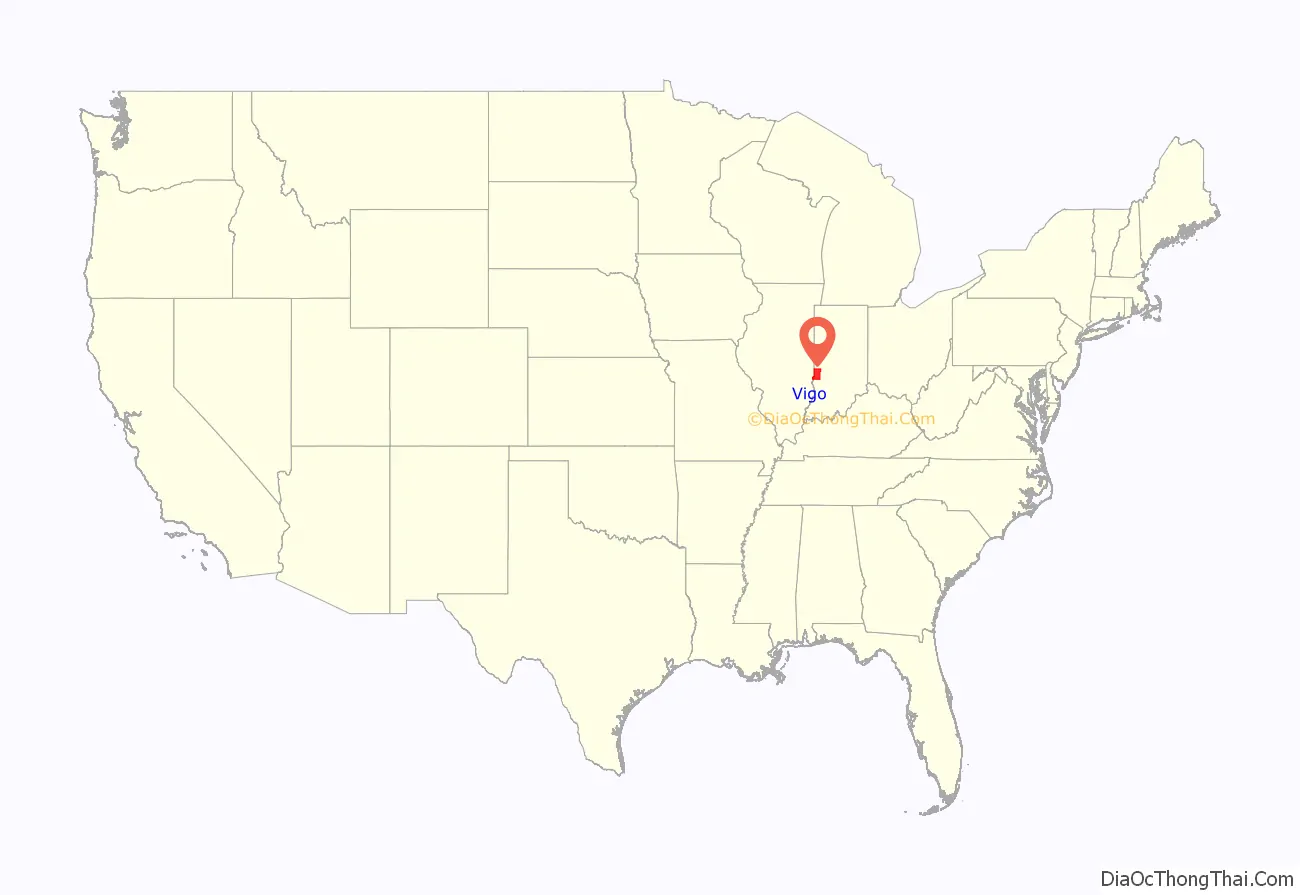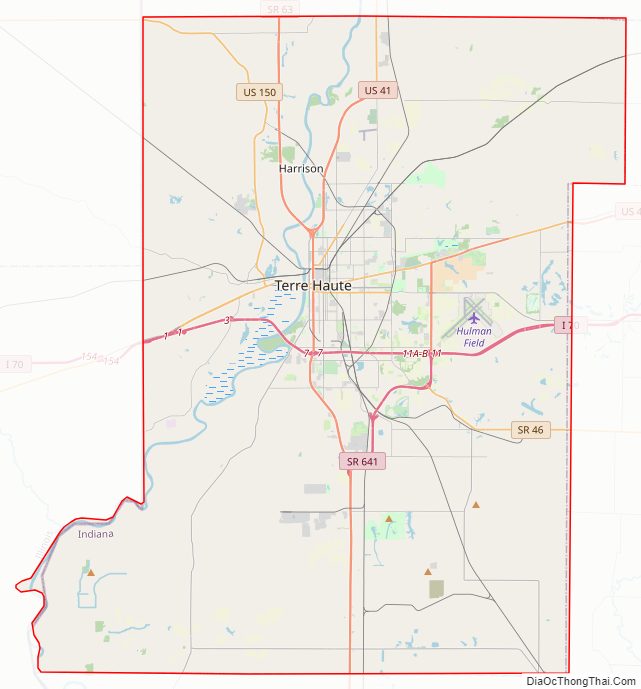Vigo County (/ˈviːɡoʊ/ VEE-goh) is a county on the western border of the U.S. state of Indiana. According to the 2020 United States Census, it had a population of 105,994. Its county seat is Terre Haute.
Vigo County is included in the Terre Haute metropolitan area.
The county contains four incorporated settlements with a total population of nearly 63,000, as well as several unincorporated communities. It is divided into twelve townships which provide local services to the residents.
The county was once regarded as one of the best bellwether regions for voting in U.S. presidential elections; it voted for the winning candidate in every election from 1956 to 2016 and in all but three elections since 1888. Until the streak ended in 2020, only one county in the United States, Valencia County, New Mexico, had voted for the winning candidate longer.
| Name: | Vigo County |
|---|---|
| FIPS code: | 18-167 |
| State: | Indiana |
| Founded: | February 1, 1818 |
| Named for: | Francis Vigo |
| Seat: | Terre Haute |
| Largest city: | Terre Haute |
| Total Area: | 410.45 sq mi (1,063.1 km²) |
| Land Area: | 403.31 sq mi (1,044.6 km²) |
| Population Density: | 258.2/sq mi (99.7/km²) |
Vigo County location map. Where is Vigo County?
History
In 1787, the fledgling United States defined the Northwest Territory, which included the area of present-day Indiana. In 1800, Congress separated Ohio from the Northwest Territory, designating the rest of the land as the Indiana Territory. President Thomas Jefferson chose William Henry Harrison as the territory’s first governor, and Vincennes was established as the territorial capital. After the Michigan Territory was separated and the Illinois Territory was formed, Indiana was reduced to its current size and geography. By December 1816 the Indiana Territory was admitted to the Union as a state.
Starting in 1794, Native American titles to Indiana lands were extinguished by usurpation, purchase, or war and treaty. The United States acquired land from the Native Americans in the 1809 treaty of Fort Wayne, and by the treaty of St. Mary’s in 1818 considerably more territory became property of the government. These two treaties resolved the occupation issue for the future Vigo County. Whites had been living in the area since 1811, when General Harrison erected a fort north of present-day Terre Haute. After the Indian skirmishes were resolved, settlers arrived in significant numbers beginning 1815.
The area in present-day Vigo County was first placed under local jurisdiction in 1790, when Knox County was created. This all-encompassing county was repeatedly subdivided as its lands were occupied − on 30 December 1816 a portion was partitioned to create Sullivan County, and on 21 January 1818 the northern portion of Sullivan was partitioned off to create Vigo County. The first county commissioners organized the government in 1818, including naming Terre Haute as its seat. The county’s borders changed several times; in 1821, part of the county was formed into Parke County, and later that year Putnam County was formed which also affected Vigo’s borders. The final change came in 1873 when the present boundaries were defined. The county is named for Colonel Francis Vigo, of Italian heritage but a citizen of Spain due to residence in St. Louis. He is credited with assisting George Rogers Clark, both in financing Clark’s exploration and American Revolutionary War efforts, and in service as an agent obtaining military information for Clark against British campaigns on the then frontier.
Vigo County Road Map
Geography
To the north of Vigo County, the Wabash River defines the boundary between Vermillion and Parke counties; the river then enters Vigo County and winds to the south-southwest, defining the southern portion of the county’s western border with Illinois before continuing south along Sullivan County‘s western border. Vigo County is thus the southernmost county in Indiana on the right bank of the Wabash. The county’s low hills are devoted to agriculture or urban development; only the drainages and river-adjacent areas are still wooded. Its highest point (680 feet (210 meters) ASL) is Sanford Hill, one mile (1.6 km) west of Paint Mill Lake, south of Terre Haute.
According to the 2010 census, the county has a total area of 410.45 square miles (1,063.1 km), of which 403.31 square miles (1,044.6 km) (or 98.26%) is land and 7.14 square miles (18.5 km) (or 1.74%) is water.
Adjacent counties
- Vermillion County – north
- Parke County – northeast
- Clay County – east
- Sullivan County – south
- Clark County, Illinois – southwest
- Edgar County, Illinois – northwest
Cities
- Terre Haute (county seat)
Towns
- West Terre Haute
- Seelyville
- Riley (or Lockport)
Census-designated places
- Dresser (or Taylorville)
- Fontanet
- New Goshen
- North Terre Haute
- Shepardsville
- Tecumseh
- Toad Hop
- Allendale
- Atherton
- Barnhart Town
- Blackhawk
- Brown Jug Corner
- Burnett
- Cherryvale
- Coal Bluff
- Cobb
- Dewey
- Duane Yards
- East Glenn
- Ehrmandale
- Ferguson Hill
- Glenn Ayr
- Gospel Grove
- Grange Corner
- Harrison
- Hickory Island
- Hutton
- Keller
- Larimer Hill
- Lewis
- Libertyville
- Liggett
- Marion Heights
- Markles
- Otter Creek Junction
- Parkview
- Pimento
- Pine Ridge
- Prairie Creek
- Prairieton
- Preston
- St. Mary-of-the-Woods
- Sandcut
- Sandford
- Shirkieville
- Southwood
- Spelterville
- Spring Hill
- State Line
- Swalls
- Tabertown
- Taylorville
- Terre Town
- Twelve Points
- Vigo
- West New Goshen
- Whitcomb Heights
- Woodgate
- Youngstown
Townships
The year after it was authorized, Vigo County was divided into four townships: Honey Creek Wabash, Harrison, and Independence. Prairie Creek Township was formed later that year. Otter Creek, Raccoon, and Sugar Creek townships were created in 1820, and Independence Township was renamed as Paris Township. Raccoon and Wabash townships became part of Parke County when it was partitioned from Vigo County in 1821. Nevins and Riley townships were formed in 1822. In 1824, Paris Township was renamed again to Fayette Township. Pierson Township was created in 1829; Lost Creek in 1831; Linton in 1841; and Prairieton Township in 1857.
- Fayette Township
- Harrison Township
- Honey Creek Township
- Linton Township
- Lost Creek Township
- Nevins Township
- Otter Creek Township
- Pierson Township
- Prairie Creek Township
- Prairieton Township
- Riley Township
- Sugar Creek Township
Highways
Interstate 70 passes through the southern part of Terre Haute from east to west on its way from Indianapolis to Saint Louis, Missouri; U.S. Route 40 roughly parallels Interstate 70 and passes through the middle of the city. Both highways intersect U.S. Route 41, coming from Chicago to the north; U.S. Route 150 enters from Paris, Illinois to the northwest and joins U.S. Route 41 in downtown Terre Haute, and both continue south toward Vincennes and Evansville.
- State Road 42
- State Road 46
- State Road 63
- State Road 159
- State Road 246
- State Road 340
- State Road 641
Rail
Several CSX Transportation railroad lines meet in Terre Haute; one enters from the north, another from the Indianapolis area, and another from Vincennes; and two others enter from Illinois. An Indiana Rail Road line runs southeast from Terre Haute toward Bedford.
Airports
The following public-use airports are located in the county:
- Terre Haute Regional Airport (HUF) in Terre Haute
- Sky King Airport (3I3) in North Terre Haute
Vigo County Topographic Map
Vigo County Satellite Map
Vigo County Outline Map
See also
Map of Indiana State and its subdivision:- Adams
- Allen
- Bartholomew
- Benton
- Blackford
- Boone
- Brown
- Carroll
- Cass
- Clark
- Clay
- Clinton
- Crawford
- Daviess
- De Kalb
- Dearborn
- Decatur
- Delaware
- Dubois
- Elkhart
- Fayette
- Floyd
- Fountain
- Franklin
- Fulton
- Gibson
- Grant
- Greene
- Hamilton
- Hancock
- Harrison
- Hendricks
- Henry
- Howard
- Huntington
- Jackson
- Jasper
- Jay
- Jefferson
- Jennings
- Johnson
- Knox
- Kosciusko
- LaGrange
- Lake
- Lake Michigan
- LaPorte
- Lawrence
- Madison
- Marion
- Marshall
- Martin
- Miami
- Monroe
- Montgomery
- Morgan
- Newton
- Noble
- Ohio
- Orange
- Owen
- Parke
- Perry
- Pike
- Porter
- Posey
- Pulaski
- Putnam
- Randolph
- Ripley
- Rush
- Saint Joseph
- Scott
- Shelby
- Spencer
- Starke
- Steuben
- Sullivan
- Switzerland
- Tippecanoe
- Tipton
- Union
- Vanderburgh
- Vermillion
- Vigo
- Wabash
- Warren
- Warrick
- Washington
- Wayne
- Wells
- White
- Whitley
- Alabama
- Alaska
- Arizona
- Arkansas
- California
- Colorado
- Connecticut
- Delaware
- District of Columbia
- Florida
- Georgia
- Hawaii
- Idaho
- Illinois
- Indiana
- Iowa
- Kansas
- Kentucky
- Louisiana
- Maine
- Maryland
- Massachusetts
- Michigan
- Minnesota
- Mississippi
- Missouri
- Montana
- Nebraska
- Nevada
- New Hampshire
- New Jersey
- New Mexico
- New York
- North Carolina
- North Dakota
- Ohio
- Oklahoma
- Oregon
- Pennsylvania
- Rhode Island
- South Carolina
- South Dakota
- Tennessee
- Texas
- Utah
- Vermont
- Virginia
- Washington
- West Virginia
- Wisconsin
- Wyoming






